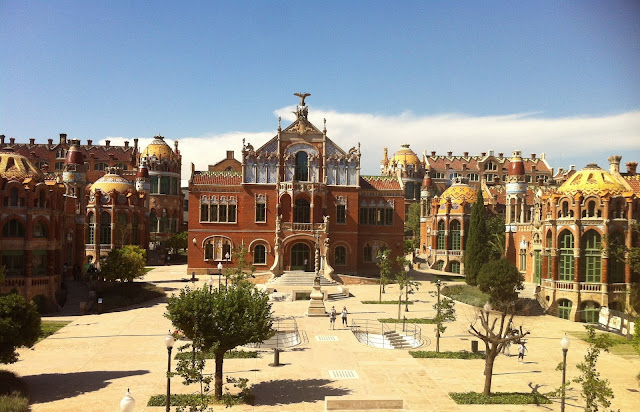 |
| My building. There Those flags hanging from the 3rd set of balconies are for Catalán independence |
This is my
building and those three Juliette-type balconies on the top floor there, that’s
my flat. Sadly the building is not one of Gaudi’s creations, but it certainly
has modernista (art nouveau) touches. I think it’s rather pretty.
Barcelona
is renowned for it’s modernista architecture
so I feel quite privileged to live in a building that somewhat lives up to that
reputation. Here are a few other nearby examples:
This part
of the city is called The Eixample –
pronounced like “eshampla”. It’s a Catalán word meaning “widening” or
“extension”, which is exactly what the area was when they built it in the late
1800s and early 1900s – an extension or widening of Barcelona.
It filled in
the gap between the existing city and surrounding towns, like Gràcia towards
the mountains - which is why the famous shopping street Passeig de Gràcia (Gràcia Passage) is called what it is - or
Sants to the south.
Of course over
time, with the building of the Eixample
these towns became incorporated into Barcelona itself – Sants is home to
Barcelona’s main railway station – but you can still tell quite clearly that
they were once separate: the Eixample’s art nouveau architecture and its distinctive road
layout makes it pretty
obvious when you enter or leave it.
The Eixample’s roads are long and straight
and in a grid formation, very different from much of the rest of the city. But
the most distinctive feature of the area is its octagonal city blocks. This
means each intersection is octagonal also – a fact that completely infuriates a
dear friend of mine when he visits from Madrid, for the extra walking it
creates to cross each intersection.
 |
| The Eixample's grid is very obvious from the air |
But despite what my friend thinks, this design is not just to annoy him. There was method
to, Idelfons Cerdà’s design “madness”: extra visibility at intersections, light and air-flow.
One of the
most impressive elements of this design you can’t actually see from the
street. Cerdà’s small blocks and the fact that the buildings that line them
don’t go back too deep means that a big open space is created on the inside of
each block. This means that even from the back of the building, plenty of light
and airflow gets into your flat.
 |
| The interior view from my flat. Shame the palm trees in the middle aren't doing too well |
This is
quite different to the older parts of town or Madrid for that matter. There,
your view from the interior of the building is often a light-well! In the
centre of Madrid, where many of the big older flats have been split up into two
or even three smaller ones, some of which are completely interior-facing, you can be left with very little light and absolutely no view (apart from your neighbours,
of course).
These days Cerdà,
the art nouveau buildings that abound in the area he designed – along with
their architects, like Guadì, but many more too - and the Eixample itself have all become, quite
rightly, treasures of Catalán culture and sources of pride. And the Eixample’s distinctive layout has become something of a symbol for the whole city.
 |
| The modernista Sant Pau hospital complex. Apparently it's the biggest art nouveau area in Europe. It's quite beautiful |
Of course
one drawback to the grid-layout, and one that Cerdà probably wasn’t thinking
about in the late 1800s, is modern-day traffic. On my particular octagonal
corner of the Eixample there’s a hell
of a lot of it.
Now traffic
noise you tend to get used to, and we have, but I do wonder just how much of that
traffic I’m breathing in when I sit inside with the balcony doors open,
enjoying that breeze that Cerdà had in mind with his design. If the dusting
that’s required in this flat is anything to go by: a lot.
And then
there are the ambulances. But I’ll let my dog Eddy tell you about that in his
own words, in the video below:
But hey,
that’s life in the city, no?





